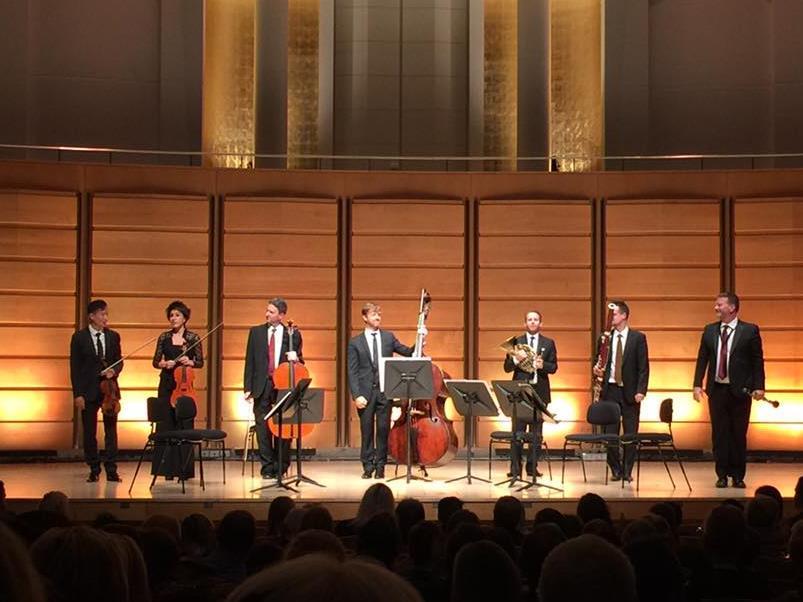Image The Australian World Orchestra via AWO.
The Australian World Orchestra comprises many of Australia’s finest orchestral musicians, from the ranks both of those who stay at home and those who hold eminent positions in orchestras around the world. Each year the orchestra comes together as an ad hoc ensemble under the artistic direction of chief conductor, Alexander Briger nephew of the late Sir Charles Mackerras. This year’s program also included a tour by a chamber ensemble of eight (AWO Chamber 8). Along with masterclasses and lessons with children across the country, the program culminated in a performance of Olivier Messiaen’s colossal Turangalîla-Symphonie directed by conductor Simone Young in Hamer Hall, Melbourne where 50 eager and feisty young musicians from the Australian National Academy of Music were mentored by the orchestra.
However, the performance on Thursday evening featured just two chamber works: Beethoven’s Septet for clarinet, horn, bassoon, violin, viola, cello and double bass, Op 20 and Dvořák’s rarely performed but highly entertaining Quintet No 2 in G major for two violins, viola, cello and double bass, Op 77. Those who enjoy the stirring excitement of Beethoven’s revolutionary creative spirit may be surprised by this somewhat sedate Septet in E flat major, Op 20 composed in 1800. Still a relative newcomer to the Austrian capital, Beethoven was careful to impress established Viennese society with a work that resembled an 18th century serenade or divertimento used as background music to a dinner or reception. It was first performed at a benefit concert for the composer – he did quite well from its proceeds – and was dedicated to the second wife of Emperor Franz II and sister-in-law of Beethoven’s patron Archduke Rudolph, the Empress Maria Theresa, who attended the concert. The dedication was no doubt a shrewd move on the composer’s part.
The Septet was a hit from its first hearing, leading to the need for several transcriptions and arrangements including for solo piano, piano four-hands, piano quartet and a version for clarinet or violin with piano and cello (Op 38), but later in life the composer came to resent the ongoing success of this lighthearted and entertaining invention, complaining that several other of his perhaps more honest and valuable works demanded similar if not greater recognition.
The AWO Chamber 8 performance revealed a finely conceived work which, though hardly deep, delighted for its light, lively and carefree music. The ensemble made an excellent combined sound, displaying a particularly fine rapport between wind and horn and excellent intonation within the strings. There were blemishes here and there, including an unsettled opening Allegro con brio and a too early entry in the first movement, but overall the level of chamber musicianship was highly satisfying. Animated clarinet playing from Paul Dean was a highpoint. The hushed opening of his Adagio cantabile enchanted. Skilful double bass playing from Matthew McDonald impressed, as did the direct quality of sonority from Lyndon Watts, bassoon and Andrew Bain, horn. All that was lacking was a clearer articulation of syntax from the whole ensemble that surely would come from playing together more often.
Czech composer Antonín Dvořák, himself a violist and keen chamber musician, composed his Quintet No 2 in 1841 as his Op18. It was revised thirteen years later, principally without the central Intermezzo movement, the composer considering the overall work too long. Dvořák‘s German publisher, Simrock, eager to promote the composition as a recent work, however, allocated a higher opus number, Op 77 despite the composer’s objections. This is an earnest and youthful conception. Hardly ever performed, it was a delight to hear once again. Though arguably somewhat straightforward in content, it contains the composer’s well-known authentic Czech spirit. Dedicated To my Country, the first performance took place in Prague.
This rousing and articulate performance was subtly expressive, particularly in the lovely shading back of phrases and rhythmic intricacy of the Scherzo (Allegro vivace), and the violin duet in the recapitulation of the Poco andante, the work’s emotional core. Violinists Natalie Chee and Daniel Dodds were notable for their excellent intonation and beautiful tone throughout. The Finale (Allegro assai) provided an ebullient conclusion to the concert with each musician fully extended.
Rating: 4 stars out of 5
AWO Chamber 8 – Melbourne Recital Centre
Natalie Chee, violin (SWR Symphonieorchester Stuttgart)
Daniel Dodds, violin (Festival Strings Lucerne)
Tahlia Petrosian, viola (Gewandhausorchester Leipzig)
David Berlin, cello (Melbourne Symphony Orchestra)
Matthew McDonald, double bass (Berlin Philharmonic Orchestra)
Paul Dean, clarinet (Queensland Conservatorium)
Lyndon Watts, bassoon (formerly Münchner Philharmoniker)
Andrew Bain, horn (Los Angeles Philharmonic)
Thursday, 27 July, 2017
Elisabeth Murdoch Hall, Melbourne Recital Centre
7.30pm





